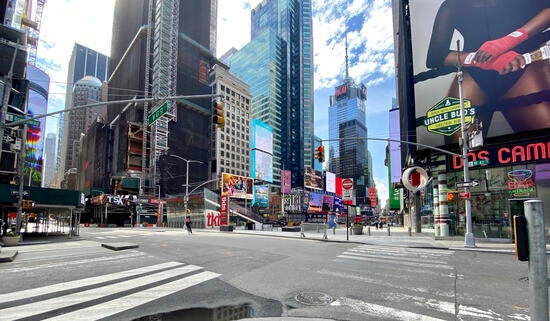
The lockdowns at the beginning of COVID-19 pandemic reduced the spread of infection by an estimated 56%, a recent study has found. If all governors did not issue any lockdowns until April 23, 2020, the number of cases would have been five times higher by April 30, 2020, the study asserts.
But the lockdowns came with economic costs.
Specifically, the U.S. lockdowns reduced gross domestic product, or GDP (−5.4%); employment (−2%); customer satisfaction (−2%), and consumer spending (−7.5%) for the next quarter. These impacts, on average, translated to a cost of $27,567 in lower GDP, according to “Lockdown Without Loss? A Natural Experiment of Net Payoffs from COVID-19 Lockdowns,” which is forthcoming in the Journal of Public Policy and Marketing.
The study is the first to capture the tradeoffs of lockdowns, weighing the effectiveness of disease reduction with their economic cost.
“Understanding the true costs and benefits of COVID-19 policies helps policymakers assess the payoff of past decisions and prepares them to navigate future large-scale health crises,” said co-author Ashish Sood, a marketing professor at the University of California, Riverside, and a research fellow at the Center of Global Innovation, University of Southern California.
“By examining the causal effects of state-ordered lockdowns, our research accurately reveals the trade-off: Lockdowns are effective in reducing the spread of the virus, but they come at a measurable cost to the economy and consumers,” added co-author Gerard J. Tellis, Neely Chaired Professor of American Enterprise at the USC Marshall School of Business.
The other authors are Sajeev Nair, assistant professor of marketing at School of Business, University of Kansas, and Nitish Sood, a student at the Medical College of Georgia at Augusta University.
A federal policy to control COVID-19 did not exist in 2020, which allowed state governors to decide when and if to order lockdowns and mask mandates. Mandatory stay-at-home orders were enacted at different times, creating a unique natural experiment that authors exploited to address four issues: their effectiveness, the cost to the economy and consumers, their effects on mask adoption, and why governors varied in ordering them.
Notably, lockdowns increased the public’s use of face masks.
“Preventive measures like mask usage and social distancing help reduce the transmission of the disease and the number of sick patients in hospitals,” said Nitish Sood. The study found that lockdowns increased mask usage by 17.9%.
The study highlights how tensions between medical science and behavioral theories have fundamental implications for public policy, management, and consumers. Despite the economic costs, avoiding lockdowns in the belief that consumers would adopt masks may backfire.
“Many experts thought that lockdowns would mitigate the need for masks. However, we found that lockdowns increased mask-wearing probably due to its signaling effect of the urgency of a pandemic,” said Sajeev Nair.
Importantly, the study’s authors show that the spread of the disease had no effect on governors’ decisions, as public health professionals hoped. Rather, the study found that governors were primarily motivated by political affiliation, imitating the policy of states affected earlier, and actions of governors of the same party who acted earlier.
(Cover: The Santa Monica beach during 2020 COVID-19 lockdowns/Getty Images)





